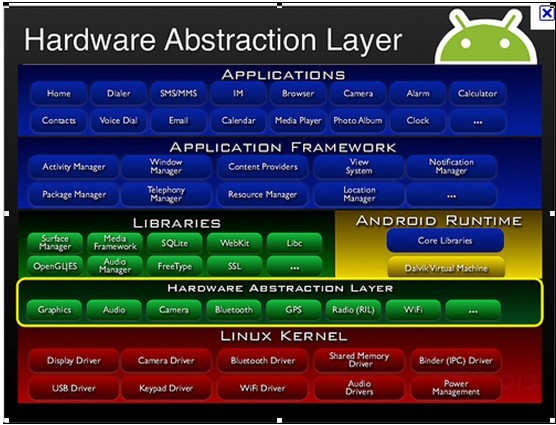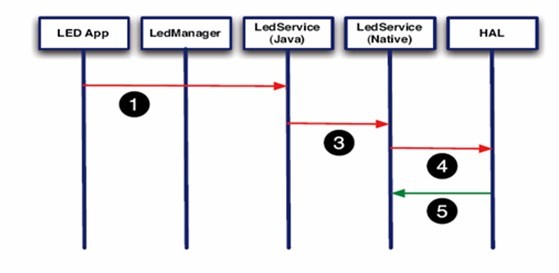android HAL 教程(含实例)
http://www.cnblogs.com/armlinux/archive/2012/01/14/2396768.html
Android Hal 分析
-------rockchip Andy
本文是基于android4.0.3.对应其他低版本的代码,可能有所差异,但基本大同小异。
1.产生HAL的原因
Android的HAL是为了保护一些硬件提供商的知识产权而提出的,是为了避开linux的GPL束缚。思路是把控制硬件的动作都放到了Android HAL中,而linux driver仅仅完成一些简单的数据交互作用,甚至把硬件寄存器空间直接映射到user space。而Android是基于Apache的license,因此硬件厂商可以只提供二进制代码,所以说Android只是一个开放的平台,并不是一个开源的平台。也许也正是因为Android不遵从GPL,所以Greg Kroah-Hartman才在2.6.33内核将Andorid驱动从linux中删除。GPL和硬件厂商目前还是有着无法弥合的裂痕。Android想要把这个问题处理好也是不容易的。
总结下来,Android HAL存在的原因主要有:
- 并不是所有的硬件设备都有标准的linux kernel的接口
- KERNEL DRIVER涉及到GPL的版权。某些设备制造商并不原因公开硬件驱动,所以才去用HAL方 式绕过GPL。
- 针对某些硬件,An有一些特殊的需求
现有HAL架构由Patrick Brady (Google) 在2008 Google I/O演讲中提出的,如下图:

2.源码目录介绍
- /hardware/libhardware_legacy/ 旧的架构、采取链接库模块的方式
- /hardware/libhardware 新架构、调整为 HAL stub。
- /hardware/ril 无线电抽象层
- 一般除了它们3个都是硬件厂商相关的hal目录。
2.1 libhardware目录的结构如下
/hardware/libhardware/hardware.c 编译成libhardware.s置于/system/lib
/hardware/libhardware/include/hardware目录下包含如下头文件:
hardware.h 通用硬件模块头文件
copybit.h copybit模块头文件
gralloc.h gralloc模块头文件
lights.h 背光模块头文件
overlay.h overlay模块头文件
qemud.h qemud模块头文件
sensors.h 传感器模块头文件
/hardware/libhardware/modules 目录下定义了很多硬件模块
2.2 下面几个是各个厂商平台相关的hal
/hardware/msm7k
/hardware/qcom
/hardware/ti
/device/Samsung
/device/moto
这些硬件模块都编译成xxx.xxx.so,目标位置为/system/lib/hw目录
3.HAL层的两种架构与两种访问方式
3.1 两种架构
位于libhardware_legacy目录下的“旧HAL架构”和位于libhardware目录下的“新HAL架构”。两种框架如下图所示:

- libhardware_legacy 是将 *.so 文件当作shared library来使用,在runtime(JNI 部份)以 direct function call 使用 HAL module。通过直接函数调用的方式,来操作驱动程序。当然,应用程序也可以不需要通过 JNI 的方式进行,直接加载 *.so (dlopen)的做法调用*.so 里的符号(symbol)也是一种方式。总而言之是没有经过封装,上层可以直接操作硬件。
- 现在的libhardware 架构,就有stub的味道了。HAL stub 是一种代理人(proxy)的概念,stub 虽然仍是以 *.so的形式存在,但HAL已经将 *.so 隐藏起来了。Stub 向 HAL提供操作函数(operations),而 runtime 则是向 HAL 取得特定模块(stub)的 operations,再 callback 这些操作函数。这种以 indirect function call 的架构,让HAL stub 变成是一种包含关系,即 HAL 里包含了许许多多的 stub(代理人)。Runtime 只要说明类型,即 module ID,就可以取得操作函数。对于目前的HAL,可以认为Android定义了HAL层结构框架,通过几个接口访问硬件从而统一了调用方式。
Android的HAL的实现需要通过JNI(Java Native Interface),JNI简单来说就是java程序可以调用C/C++写的动态链接库,这样的话,HAL可以使用C/C++语言编写,效率更高。
3.2 调用过程如下
JNI->通用硬件模块->硬件模块->内核驱动接口.
具体一点:JNI->libhardware.so->xxx.xxx.so->kernel.
再具体来说:android frameworks中JNI调用hardware.c中定义的hw_get_module函数来获取硬件模块,然后调用硬件模块中的方法,硬件模块中的方法直接调用内核接口完成相关功能
3.3 两种访问方式
(1)Android的app可以直接通过service调用.so格式的jni

(2)经过Manager调用service

上面两种方法应该说是各有优缺点:
- 第一种方法简单高效,但不正规。
- 第二种方法实现起来比较复杂,但更符合目前的Android框架。第二种方法中,LegManager和LedService(java)在两个进程中,需要进程通讯。
在现在的android框架中,这两种方式都存在,比如对于lights,是直接透过LightsService调用JNI,而对于sensor,中间则是通过SensorsManager来调用JNI的。
4.通用硬件模块(libhardware.so)
一般来说HAL moudle需要涉及的是三个关键结构体:
- struct hw_module_t;
- struct hw_module_methods_t;
- struct hw_device_t;
这三个结构体定义在hardware.h中。
路径为:/hardware/libhardware/include/hardware/hardware.h
头文件中主要定义了通用硬件模块结构体hw_module_t,声明了JNI调用的接口函数hw_get_module。hw_module_t定义如下:
/** * Every hardware module must have a data structure named HAL_MODULE_INFO_SYM * and the fields of this data structure must begin with hw_module_t * followed by module specific information. */
typedef struct hw_module_t { /** tag must be initialized to HARDWARE_MODULE_TAG */
uint32_t tag; /** major version number for the module */
uint16_t version_major; /** minor version number of the module */
uint16_t version_minor; /** Identifier of module */
const char *id; /** Name of this module */
const char *name; /** Author/owner/implementor of the module */
const char *author; /** Modules methods */
struct hw_module_methods_t* methods; //硬件模块的方法 /** module's dso */
void* dso; /** padding to 128 bytes, reserved for future use */
uint32_t reserved[-]; } hw_module_t;
如注释所说,所有的hal模块都要有一个以HAL_MODULE_INFO_SYM命名的结构,而且这个结构要以hw_module_t为第一个成员,即要继承hw_module_t这个结构,比如lights,sensor:
struct sensors_module_t {
struct hw_module_t common;
int (*get_sensors_list)(struct sensors_module_t* module,
struct sensor_t const** list);
};
/*
* The lights Module
*/
struct light_module_t HAL_MODULE_INFO_SYM = {
.common: {
tag: HARDWARE_MODULE_TAG,
version_major: ,
version_minor: ,
id: LIGHTS_HARDWARE_MODULE_ID,
name: "Lights module",
author: "Rockchip",
methods: &light_module_methods,
}
};
const struct sensors_module_t HAL_MODULE_INFO_SYM = {
.common = {
.tag = HARDWARE_MODULE_TAG,
.version_major = ,
.version_minor = ,
.id = SENSORS_HARDWARE_MODULE_ID,
.name = "Stingray SENSORS Module",
.author = "Motorola",
.methods = &sensors_module_methods,
},
.get_sensors_list = sensors__get_sensors_list
};
hw_module_t中比较重要的是硬件模块方法结构体hw_module_methods_t定义如下:
typedef struct hw_module_methods_t {
/** Open a specific device */
int (*open)(const struct hw_module_t* module, const char* id,
struct hw_device_t** device);
} hw_module_methods_t;
该方法在定义HAL_MODULE_INFO_SYM的时候被初始化。目前该结构中只定义了一个open方法,其中调用的设备结构体参数hw_device_t定义如下:
/**
* Every device data structure must begin with hw_device_t
* followed by module specific public methods and attributes.
*/
typedef struct hw_device_t { /** tag must be initialized to HARDWARE_DEVICE_TAG */
uint32_t tag; /** version number for hw_device_t */
uint32_t version; /** reference to the module this device belongs to */
struct hw_module_t* module; /** padding reserved for future use */
uint32_t reserved[]; /** Close this device */
int (*close)(struct hw_device_t* device); } hw_device_t; struct light_device_t {
struct hw_device_t common;
int (*set_light)(struct light_device_t* dev,
struct light_state_t const* state);
}; /** * Every device data structure must begin with hw_device_t
* followed by module specific public methods and attributes.
*/
struct sensors_poll_device_t {
struct hw_device_t common;
int (*activate)(struct sensors_poll_device_t *dev,
int handle, int enabled); int (*setDelay)(struct sensors_poll_device_t *dev,
int handle, int64_t ns); int (*poll)(struct sensors_poll_device_t *dev,
sensors_event_t* data, int count); };
亦如注释所说,每一个设备的数据结构都必须也以hw_device_t为第一个成员。
5.以lights模块为例进行分析
5.1 源文件位置:(android5.1源码)
- /frameworks/base/services/core/java/com/android/server/lights/
- /frameworks/base/services/core/jni/com_android_server_lights_LightsService.cpp
- /hardware/libhardware/include/hardware/lights.h
5.2 访问设备大概流程
app--->frameworks--->hardware--->kernel驱动
frameworks通过jni调用hw_get_module()获得HAL对应的模块,它的声明如下:
int hw_get_module(const char *id, const struct hw_module_t **module);
- 参数id为模块标识,定义在/hardware/libhardware/include/hardware录下的硬件模块头文件中
- 参数module是硬件模块地址,定义在/hardware/libhardware/include/hardware/hardware.h中
在lights.h中定义有lights模块的ID.
#define LIGHTS_HARDWARE_MODULE_ID "lights"
在5.1源码frameworks/base/services/core/jni/com_android_server_LightsService.cpp的init_native方法中调用hw_ge_module(),代码如下:
static jint init_native(JNIEnv *env, jobject clazz)
{
int err;
hw_module_t* module;
Devices* devices;
devices = (Devices*)malloc(sizeof(Devices));
err = hw_get_module(LIGHTS_HARDWARE_MODULE_ID, (hw_module_t const**)&module);
if (err == ) {
devices->lights[LIGHT_INDEX_BACKLIGHT]
= get_device(module, LIGHT_ID_BACKLIGHT);
//………………………………………….
}
hw_get_module函数在hardware.c中实现:
int hw_get_module(const char *id, const struct hw_module_t **module)
{
return hw_get_module_by_class(id, NULL, module);
}
再看hw_get_module_by_class时如何实现的:
首先在hardware.c的开始有如下定义和注释:
/** Base path of the hal modules */
#define HAL_LIBRARY_PATH1 "/system/lib/hw"
#define HAL_LIBRARY_PATH2 "/vendor/lib/hw" /**
* There are a set of variant filename for modules. The form of the filename
* is "<MODULE_ID>.variant.so" so for the led module the Dream variants
* of base "ro.product.board", "ro.board.platform" and "ro.arch" would be:
*
* led.trout.so
* led.msm7k.so
* led.ARMV6.so
* led.default.so
*/ static const char *variant_keys[] = {
"ro.hardware", /* This goes first so that it can pick up a different
file on the emulator. */
"ro.product.board",
"ro.board.platform",
"ro.arch"
}; static const int HAL_VARIANT_KEYS_COUNT =
(sizeof(variant_keys)/sizeof(variant_keys[])); int hw_get_module_by_class(const char *class_id, const char *inst,
const struct hw_module_t **module) {
int status;
int i;
const struct hw_module_t *hmi = NULL;
char prop[PATH_MAX];
char path[PATH_MAX];
char name[PATH_MAX]; if (inst)
snprintf(name, PATH_MAX, "%s.%s", class_id, inst);
else
strlcpy(name, class_id, PATH_MAX); /*
* Here we rely on the fact that calling dlopen multiple times on
* the same .so will simply increment a refcount (and not load
* a new copy of the library).
* We also assume that dlopen() is thread-safe.
*/ /* Loop through the configuration variants looking for a module */
for (i = ; i < HAL_VARIANT_KEYS_COUNT + 1 ; i++) {
if (i < HAL_VARIANT_KEYS_COUNT) {
if (property_get(variant_keys[i], prop, NULL) == ) {
continue;
}
snprintf(path, sizeof(path), "%s/%s.%s.so",
HAL_LIBRARY_PATH2, name, prop);
if (access(path, R_OK) == ) break; snprintf(path, sizeof(path), "%s/%s.%s.so",
HAL_LIBRARY_PATH1, name, prop);
if (access(path, R_OK) == ) break;
} else {
snprintf(path, sizeof(path), "%s/%s.default.so",
HAL_LIBRARY_PATH1, name);
if (access(path, R_OK) == ) break;
}
}
status = -ENOENT;
if (i < HAL_VARIANT_KEYS_COUNT + ) {
/* load the module, if this fails, we're doomed, and we should not try
* to load a different variant. */
status = load(class_id, path, module);
}
return status; }
可以看到,在hw_get_module_by_class函数中:
- 先通过property_get获得varient_key中定义的系统属性,
- 如果系统中有定义该属性,就会获得一个模块名.属性名组成的一个so的名称,
- 然后去/system/lib/hw、/vendor/lib/hw下查看,该so是否存在,如果存在,调用load函数,打开.so.
例如在rockchip的rk29平台上,有定义ro.product.board = rk29sdk,在这里会得到lights.rk29sdk.so。
再看load函数的实现:
/**
* Load the file defined by the variant and if successful
* return the dlopen handle and the hmi.
* @return 0 = success, !0 = failure.
*/
static int load(const char *id,
const char *path,
const struct hw_module_t **pHmi)
{
int status;
void *handle;
struct hw_module_t *hmi; /*
* load the symbols resolving undefined symbols before
* dlopen returns. Since RTLD_GLOBAL is not or'd in with
* RTLD_NOW the external symbols will not be global
*/
handle = dlopen(path, RTLD_NOW);
if (handle == NULL) {
char const *err_str = dlerror();
ALOGE("load: module=%s\n%s", path, err_str?err_str:"unknown");
status = -EINVAL;
goto done;
}
/* Get the address of the struct hal_module_info. */
const char *sym = HAL_MODULE_INFO_SYM_AS_STR;
hmi = (struct hw_module_t *)dlsym(handle, sym);
if (hmi == NULL) {
ALOGE("load: couldn't find symbol %s", sym);
status = -EINVAL;
goto done;
} /* Check that the id matches */
if (strcmp(id, hmi->id) != ) {
ALOGE("load: id=%s != hmi->id=%s", id, hmi->id);
status = -EINVAL;
goto done;
}
hmi->dso = handle;
/* success */
status = ;
done:
if (status != ) {
hmi = NULL;
if (handle != NULL) {
dlclose(handle);
handle = NULL;
}
} else {
ALOGV("loaded HAL id=%s path=%s hmi=%p handle=%p",
id, path, *pHmi, handle);
}
*pHmi = hmi;
return status;
}
在这里会打开对应了so,比如lights.rk29sdk.so,然后获得这个模块中定义的hw_module_t的地址。后面JNI就能通过这个接口和hal层进行沟通了。
6.HAL与frameworks关联代码如下
public class LightsService extends SystemService {
//...
private void setLightLocked(int color, int mode, int onMS, int offMS, int brightnessMode) {
if (color != mColor || mode != mMode || onMS != mOnMS || offMS != mOffMS) {
if (DEBUG) Slog.v(TAG, "setLight #" + mId + ": color=#"
+ Integer.toHexString(color));
mColor = color;
mMode = mode;
mOnMS = onMS;
mOffMS = offMS;
Trace.traceBegin(Trace.TRACE_TAG_POWER, "setLight(" + mId + ", " + color + ")");
try {
setLight_native(mNativePointer, mId, color, mode, onMS, offMS, brightnessMode);
} finally {
Trace.traceEnd(Trace.TRACE_TAG_POWER);
}
}
}
public LightsService(Context context) {
super(context);
mNativePointer = init_native();
//...
}
private static native long init_native();//这里调用HAL层的hw_get_module
private static native void finalize_native(long ptr);
static native void setLight_native(long ptr, int light, int color, int mode,
int onMS, int offMS, int brightnessMode);//访问硬件
private long mNativePointer;//保存hal返回的句柄
}
android HAL 教程(含实例)的更多相关文章
- 【转】Android HAL实例解析
原文网址:http://www.embedu.org/Column/Column339.htm 作者:刘老师,华清远见嵌入式学院讲师. 一.概述 本文希望通过分析台湾的Jollen的mokoid 工程 ...
- Android HAL实例解析
一.概述 本文希望通过分析台湾的Jollen的mokoid 工程代码,和在s5pc100平台上实现过程种遇到的问题,解析Andorid HAL的开发方法. 二.HAL介绍 现有HAL架构由Patric ...
- mybaits入门(含实例教程和源码) http://blog.csdn.net/u013142781/article/details/50388204
前言:mybatis是一个非常优秀的存储过程和高级映射的优秀持久层框架.大大简化了,数据库操作中的常用操作.下面将介绍mybatis的一些概念和在eclipse上的实际项目搭建使用. 一.mybati ...
- .NET开发邮件发送功能的全面教程(含邮件组件源码)
今天,给大家分享的是如何在.NET平台中开发“邮件发送”功能.在网上搜的到的各种资料一般都介绍的比较简单,那今天我想比较细的整理介绍下: 1) 邮件基础理论知识 2) ...
- ArcGIS Runtime for Android开发教程V2.0(1)基本概念
原文地址: ArcGIS Runtime for Android开发教程V2.0(1)基本概念 - ArcGIS_Mobile的专栏 - 博客频道 - CSDN.NET http://blog.csd ...
- Spring中@Transactional事务回滚(含实例详细讲解,附源码)
一.使用场景举例 在了解@Transactional怎么用之前我们必须要先知道@Transactional有什么用.下面举个栗子:比如一个部门里面有很多成员,这两者分别保存在部门表和成员表里面,在删除 ...
- [读后感]spring Mvc 教程框架实例以及系统演示下载
[读后感]spring Mvc 教程框架实例以及系统演示下载 太阳火神的漂亮人生 (http://blog.csdn.net/opengl_es) 本文遵循"署名-非商业用途-保持一致&qu ...
- Spring中@Transactional事务回滚(含实例具体解说,附源代码)
一.使用场景举例 在了解@Transactional怎么用之前我们必须要先知道@Transactional有什么用. 以下举个栗子:比方一个部门里面有非常多成员,这两者分别保存在部门表和成员表里面,在 ...
- linux.linuxidc.com - /2011年资料/Android入门教程/
本文转自 http://itindex.net/detail/15843-linux.linuxidc.com-%E8%B5%84%E6%96%99-android Shared by Yuan 用户 ...
随机推荐
- 数据库 定义 bit 类型 (true=1,false=0)
当Sql Server数据库定义 数据 为 bit 类型时, 编写代码时 要用 true or false 赋值. 例如: OffTheShelf 定义类型为 bit 后台赋值时 OffTheSh ...
- linux suse系统防火墙端口开放配置
1.切换到root用户下 2.进入到/etc/sysconfig/SuSEfirewall2 3.修改FW_SERVICES_EXT_TCP=" 22 80 8080 8081 8082 8 ...
- LeetCode Plus One Linked List
原题链接在这里:https://leetcode.com/problems/plus-one-linked-list/ 题目: Given a non-negative number represen ...
- 在github分支上上传空文件夹
GIT工具是依靠文件来识别文件夹的,对于空的文件夹是不能识别的.因此如果需要在代码中增加一个空文件夹,同时需要在文件夹中增加一个空文件.gitkeep 当批量增加空文件夹时,可以在GIT库的根目录下输 ...
- iOS 单例的销毁
今天做项目的时候,对于不同的用户,需要创建不同的数据库.但是退出登录切换账号时,因为用单例创建数据,导致切换账号不会切换数据.所以,需要销毁单例.销毁单例时,调用以下的代码: 在创建单例的那个类中,调 ...
- sed
命令行格式为: sed [-nefri] ‘command’ 输入文本/文件 常用选项: -n∶取消默认的输出,使用安静(silent)模式.在一般 sed 的用法中 ...
- linux昨天修改的文件
find ./ -mtime :返回最近24小时内修改过的文件. find ./ -mtime : 返回的是前48~24小时修改过的文件.而不是48小时以内修改过的文件. Linux查找文件内容的常用 ...
- 夺命雷公狗-----React---28--小案例之react经典案例todos(全选和反选)完
这个功能实现的步骤如下所示: 最终实现全选和反选,代码如下所示: <!DOCTYPE html> <html lang="en"> <head> ...
- 控制反转Inversion of Control (IoC) 与 依赖注入Dependency Injection (DI)
控制反转和依赖注入 控制反转和依赖注入是两个密不可分的方法用来分离你应用程序中的依赖性.控制反转Inversion of Control (IoC) 意味着一个对象不会新创建一个对象并依赖着它来完成工 ...
- python 国内源
pipy国内镜像目前有: http://pypi.douban.com/ 豆瓣 http://pypi.hustunique.com/ 华中理工大学 http://pypi.sdutlinux.o ...
